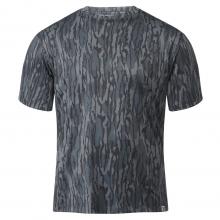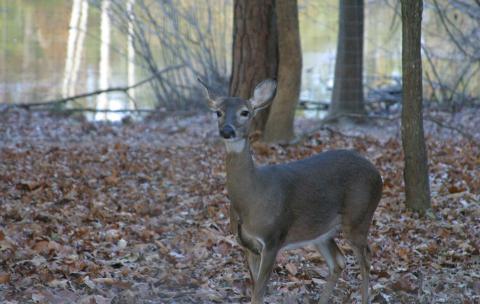By Heath Wood
As the leaves begin to turn and a crispness fills the air, October marks a momentous time in the whitetail deer woods. This month bridges the predictability of early season patterns, followed by the sudden change into the chaotic frenzy of the rut.
After nearly thirty years of hunting whitetail deer, I am still baffled at the peculiar behavior of bucks. When mature bucks undergo the noticeable behavioral change as they transition into the pre-rut phase, it is almost as if you flipped a light switch in their brain. Although sometimes frustrating, this notorious behavior change allows savvy hunters to capitalize on these shifts, making October one of the best times to be in the woods. There is a small window in early October when some bucks may still be in a predictable pattern. Yet, their behavior indicates the urge to display dominance and begin showing off to the ladies for the upcoming breeding season. For example, bucks may still spend much of the day together. Yet, as tensions build, they become less tolerant of each other, leading them to rub trees in aggravation and make scrapes to begin taking a stand on their territory.
Understanding how bucks adjust their travel patterns, bedding routines, and interactions with other deer can offer significant advantages as they near one of the hunters’ favorite times to hunt: the rut!

Understanding October Deer Behavior: A Pre-Rut Transformation
As the days progress and testosterone levels rise, subtle yet significant changes occur among whitetail bucks. Bucks become more active during daylight hours, and their travel patterns expand as they search for the first signs of receptive does. This heightened movement is part of a behavioral shift often referred to as the pre-rut when hunters should be prepared to take leverage.
The Importance of Rubs and Scrapes
Rubs and scrapes are key indicators of deer activity during the pre-rut period. Bucks begin to lay down rubs along their travel routes, using these visual markers to assert dominance and establish their presence, not to mention giving us hunters hope for tagging our dream buck for that year. Observing fresh rubs can give hunters a better understanding of where bucks are moving and, more importantly, when they’re moving. Scrapes, on the other hand, serve as communication hubs for deer. Many years ago, I heard a notable hunter refer to scrape activity as a place where bucks and does leave their business card to tell other deer they have been in the area. Today, I would relate this communication hub to a dating site where you click interested or not. Bucks will create scrapes in high-traffic areas as a way to advertise their presence to does, enticing them to leave their scent or click interested. Yet, it also creates a challenge for other bucks. A scrape typically consists of a cleared patch of ground with an overhanging branch where bucks will rub their forehead glands and urinate. This behavior releases pheromones that signal their presence and readiness to breed, giving hunters the needed sign to hunt that area.
Locating Core Areas: Bedding and Feeding
As October unfolds, hunters must adjust their focus from food sources to the areas bucks use during the day. Bucks will begin spending more time in their core areas, often consisting of thick cover near food sources or secluded bedding areas. To locate these core areas, pay attention to bedding locations in relation to food plots, acorn-rich hardwoods, or crop fields.
During the pre-rut, mature bucks may bed in the same general area as does but on the fringes, where they can monitor movement and scent-check for estrous signs. Setting up along these travel routes, such as trails connecting bedding areas to the feeding zone, will increase your odds of encountering a mature buck as he shifts between feeding and scent-checking for does. This is often where most scrapes will be found.
Strategic Stand Placements for October Success

When the signs of the rut began to show up in our hunting areas, we began hunting more often. Hunting pressure can make bucks skittish in October, so it is crucial to select your stand placement carefully.
Positioning your stand in a transition zone—where thick bedding areas meet open fields or acorn flats can offer the perfect vantage point to catch mature bucks moving between feeding and bedding areas. Bucks are often cautious in these zones but are more likely to use them as they expand their range during the pre-rut. Another popular pre-rut stand site is setting up downwind of a known bedding area, which can be highly effective, especially during midday when bucks are most likely to be on their feet.
One of my favorite October stand locations is near an active scrape line so that I can observe bucks checking scrapes during daylight hours. While younger bucks frequently check scrapes, mature bucks are often more sly in their movements and visit these areas cautiously. When they do, I’ll be there waiting to take the shot. One of my favorite ways to speed up a mature buck checking scrapes is by creating mock scrapes. Making a scrape near a buck scrape is an excellent way to attract bucks and hold them in your hunting area longer. Since I was a kid, watching old Tom Miranda videos of him luring bucks in with deer lures and videos of Ben Lee using the tarsal glands off of a buck he had harvested to lure other bucks, I have had a passion for using scents.
I have loved monitoring mock scrapes with trail cameras for the past ten years. These cameras can provide invaluable insights into which bucks frequent the area and when they’re most active. This knowledge can help you fine-tune your hunting strategy and increase the odds of an encounter.
Calling Techniques: When and How to Call During the Pre-Rut
In October, hunters get to use all their gadgets and tools to lure deer. As with using scents, calling during the pre-rut can also be a double-edged sword. Rattling, grunting, and doe bleats can attract bucks from a distance when used correctly. However, aggressive calling can also spook cautious, mature bucks. I have found using softer, more subtle calls like doe bleats and young buck grunts early in the month works better because they are less likely to intimidate and can pique the curiosity of a passing buck.
As October progresses and bucks become more aggressive, light rattling can simulate a sparring match between younger bucks. Use a rattling bag or antlers and rattle softly, mimicking the sound of bucks testing each other’s strength. You don’t want to sound like two five-hundred-pound bucks battling for their lives; other bucks can often be intimidated and will never respond. Instead, lighter is better. By the end of October, bucks may be more responsive to aggressive calling, especially tending grunts and snort-wheezes. Use these sparingly, as mature bucks are more likely to approach cautiously and circle downwind before committing.
Adapting to October Challenges: Weather
Weather also plays a crucial role in October hunting success. Cold fronts are a prime time to be in the woods, as they often trigger increased deer movement, especially during daylight hours. Pay close attention to changes in temperature, barometric pressure, and wind direction. Plan your hunts around these shifts, as bucks are likelier to be on their feet during cooler, high-pressure days. During prime days, scrapes will be more active; scents will work better. And bucks are more likely to respond to calls.
Mastering the October rut requires a blend of observation, strategy, and adaptability. As bucks transition into the pre-rut phase, hunters need to adjust their tactics to take advantage of increased daylight activity, shifting travel patterns and using rubs and scrapes. By focusing on strategic stand placements, utilizing mock scrapes, and employing effective calling techniques, you can position yourself for a successful hunt. The key is to remain patient, pay attention to the changing behavior of bucks, and capitalize on their heightened movement during this exciting time of year. With the right approach, October can offer some of the best opportunities to tag a mature buck before the frenzy of the rut begins.






























